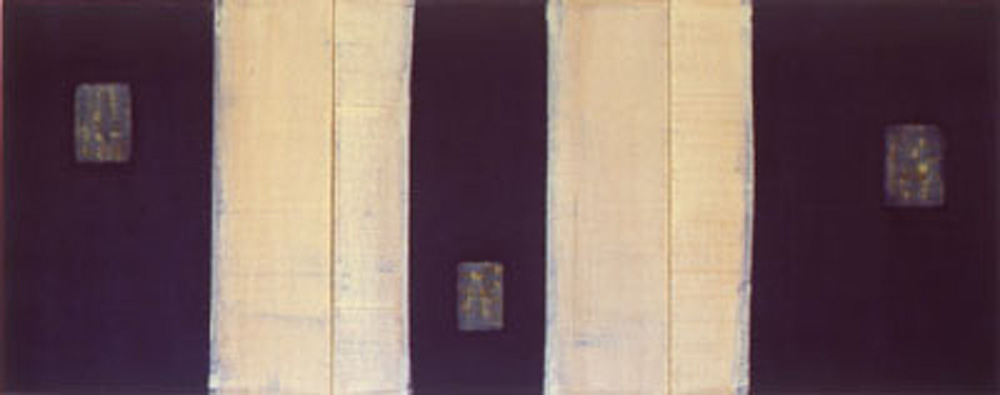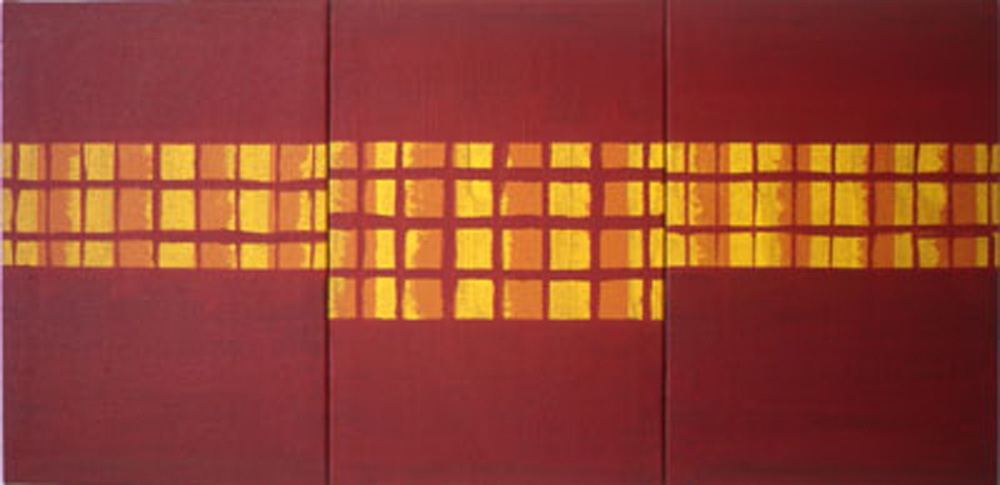Steven Foy: The ‘Bitter, Sweet’ Paintings
Michael White
In his recent ‘Bitter, Sweet’ series, Steven Foy has produced a rich combination of contemporary abstract painting with the longstanding tradition of the triptych or three panelled work most familiar in religious art. Immediately such a pairing speaks of contrasts: the old with the new, the sacred and the secular, the mysterious and the matter-of-fact. As he related to me in conversation, the triptych offered itself to him quite naturally. It was not a contrived decision nor an attempt to imbue his painting with content by association. Rather it developed of its own accord from his compositional procedures and his interest in producing overlapping and interweaving spaces. Like all of his paintings, the ‘Bitter, Sweet’ works bear close scrutiny and as the title suggest, their aftertaste lingers.

Bitter, sweet no 20, 2001. 48 x 122cms. Acrylic on cotton duck
But should it not be ‘Bitter-sweet’? Replacing the hyphen with a comma seems to be a deliberate ploy creating a pause between the two words, highlighting their distance. The thing about a hyphen is that it is not really there anyway – it does nothing on its own. It stands for a space between two words or it links them together. It is simultaneously separation and conjunction. Bitterness and sweetness are always going to be different sensations but they can be experienced at the same moment which is all the hyphen represents. Given the different temporal consumption of paintings to words it is no surprise that they often offer complex combinations of experience the hyphenation of which goes unnoticed. You may call to mind all of the frightening-seductive De Koonings, the gloomy-joyful Rothkos or even the brutal-merciful nature of just about every crucifixion scene you have ever looked at. Foy suggests that we may be able to draw out the experience of these contrasts a little longer to savour them. This follows from his many years of working with the expressive possibilities of antithesis translated into painterly terms in the structured disorder, loose tightness and open enclosure which are persistent features of his work. The intriguing thing about the ‘Bitter, Sweet’ series, however, is the presence of three components.
From medieval times onward the triptych has been used and reused as a format to express a religious narrative. There are, of course, diptychs and multi-panelled works featuring any number of parts but somehow the triptych has been the most enduring or at least has the most resonance in modern times. The reason for this may have been as much practical as liturgical. For the triptych provided a simple solution to the structure of an altarpiece. The precious interior could be kept safe and then opened on special occasions. The wings which unfolded provided the artist with a neatly symmetrical schema with which to work. The significance of the trinity in Christian theology helped to establish the priority of the triptych but it was not essential. In fact in recent times the triptych has been used to express the total absence of redemption as in Francis Bacon’s ‘Triptych: Three Studies for Figures at the Base of a Crucifixion’ (1944) which showed a world stripped of godliness. The three part scheme does not have to lead to the sublime. What it does suggest, however, is completion. Where two is always opposition and four or more a series, three provides an internal resolution. Bitter and sweet may be contrasts but they do add up to a total experience. Out of their conjunction emerges something else. ‘Bitter, Sweet no.11’, for example, is one of Foy’s most minimal works. We have two main elements, a deep purple-brown field and two Barnett Newman-like ‘zips’ of bright yellow. The acidity of the yellow against what is a richly modulated field would seem to give us our two ‘tastes’ but the overall sensation is much more than their opposition, a fact highlighted by the obvious absence of a yellow ‘zip’ on the central canvas of the triptych. It is unlike its neighbours and on its own could almost be a monochrome but it finishes the work by keeping the ‘zips’ far enough apart that they do not dominate entirely.

Bitter, sweet no 12, 2000. 28 x 57cms. Acrylic on cotton duck
‘Bitter, Sweet no.11’ exaggerates a common feature of the whole series in making an explicit feature of vertical division. Another instance can be found in ‘Bitter, Sweet no.20’ where the dividers coincide with the breaks between the individual canvases. Like a hyphen, the shadow lines are neither part of the work nor outside of it. They connect the separate parts together as much as they persistently hold them apart like the hinges on an original altarpiece. If you try to imagine these paintings as one large canvas, then something of their mystery immediately disappears. The fact that they have been painted as individual canvases and then joined together makes the balancing act they perform more precarious. The centre is often never quite where you expect if to be or, as in no.11, can be totally vacated. Such multi-part paintings also raise another spectre by quietly invoking the companion art of architecture. The altarpiece made a big play of this feature adding on all kinds of framing decorations. Even when these ornaments have been stripped away, the greater attention that the triptych draws to its hanging heightens the tension between it and the wall.
The architectural connotations of the ‘Bitter, Sweet’ paintings are often reinforced by another of Foy’s repeated motifs, the grid. As Rosalind Krauss discussed several years ago, the grid features in many modernist paintings as a marker of self reflexivity.1 Its anti-natural character makes it the perfect signifier of non-objectivity in painting. It is a form which appears to be produced quite literally out of the weave of the canvas itself. Yet as much as it wishes to close the canvas down to the surface itself, the grid repeats the image of the window on the world undermining the modernist project. In my view Foy’s fragile grids never pretend the irreducibility which Krauss described. They have always offered glimpses through and into other spaces. Thus the ‘Bitter, Sweet’ paintings double the anxiety of the partial view by the cracks or gaps that interrupt the passage from one painting to the next. ‘Bitter, Sweet no.12’ tempts us to read the grid right across all three canvases but it soon becomes clear that rather than provide one underlying structure we are presented with three voices vying with each other. They can be seen together but do not blend, like a dissonant chord, a complex taste, and bitter-sweetness.
1. Rosalind Krauss, ‘Grids’ in The Originality of the Avant-Garde and other Modernist Myths (MIT, Cambridge MA & London, 1986)